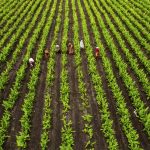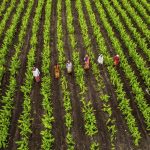Irrigation systems play a pivotal role in the success of any farming operation. As climate change impacts weather patterns and water scarcity becomes a pressing issue, the need for efficient irrigation systems has never been more critical. Farmers are now tasked with maximizing crop yields while minimizing water usage, making the implementation of effective irrigation strategies essential. This article explores the importance of efficient irrigation, key components to consider in designing your system, the innovative technologies shaping modern practices, and best maintenance practices to ensure long-term efficiency.
Understanding the Importance of Efficient Irrigation Systems
Efficient irrigation systems are vital not only for the sustainability of water resources but also for the economic viability of farms. Traditional irrigation methods often lead to excessive water consumption, which can deplete local water sources and increase operational costs. By adopting efficient systems, farmers can significantly reduce water waste, ensuring that every drop is used to nurture plants rather than being lost to evaporation or runoff.
In addition to conserving water, efficient irrigation systems contribute to improved crop health and yields. Well-managed irrigation minimizes stress on plants, promoting optimal growth conditions. This leads to healthier crops that can withstand pests and diseases better than those subjected to inconsistent watering. With the right irrigation practices, farmers can also achieve uniformity in crop production, which is essential for meeting market demands.
Moreover, efficient irrigation systems can enhance soil health. Over time, traditional irrigation methods can lead to soil erosion, nutrient depletion, and salinization. In contrast, efficient systems, such as drip irrigation, deliver water directly to the root zone. This promotes better soil structure and moisture retention while reducing the risk of nutrient runoff. As a result, farmers not only safeguard their immediate water resources but also contribute to the long-term sustainability of their land.
Key Components to Consider for Your Irrigation Setup
When designing an efficient irrigation system, several crucial components must be taken into account. First, it is essential to assess the water source, whether it is surface water, groundwater, or rainwater. Understanding the quality and availability of water throughout the growing season will influence the choice of irrigation method. Additionally, farmers should consider the layout of their fields, as this will determine the most effective distribution of water.
The selection of irrigation technology is another critical consideration. Traditional methods, such as flood or furrow irrigation, may be less efficient compared to modern techniques like drip or sprinkler systems. Drip irrigation, for instance, delivers water directly to the plant roots, minimizing evaporation and runoff. Sprinkler systems, on the other hand, can cover large areas but may require careful scheduling to prevent water loss. Each method has its advantages and should be chosen based on the unique demands of the farm’s crops and terrain.
Finally, the implementation of a robust monitoring system is essential for ensuring optimal irrigation practices. Utilizing soil moisture sensors, weather stations, and automated controls can help farmers make data-driven decisions about when and how much to irrigate. This technology not only enhances efficiency but also allows for timely adjustments based on changing environmental conditions, ultimately leading to more sustainable water management.
Innovative Technologies Transforming Irrigation Practices
The landscape of irrigation is rapidly changing with the advent of innovative technologies that enhance efficiency and reduce resource waste. One of the most impactful advancements is precision agriculture, which utilizes data analytics and sensor technology to optimize irrigation schedules. By collecting real-time data on soil moisture, temperature, and plant health, farmers can make informed decisions that ensure water is applied only when necessary.
Another significant innovation is the development of smart irrigation systems that integrate with mobile applications. These systems allow farmers to remotely monitor and control their irrigation practices, providing flexibility and the ability to respond quickly to changing conditions. With features like automatic adjustments based on weather forecasts, these smart systems help prevent over-irrigation, thereby conserving water and reducing costs.
Moreover, advancements in materials and design have led to the creation of more durable and efficient irrigation equipment. For example, low-pressure drip emitters and high-efficiency sprinklers can minimize energy consumption while maximizing water delivery. As agricultural technology continues to evolve, these innovations promise not only to improve crop productivity but also to create a more sustainable approach to farming.
Best Practices for Maintenance and System Optimization
To ensure the longevity and efficiency of an irrigation system, regular maintenance is crucial. Farmers should establish a routine inspection schedule to check for leaks, clogs, and other issues that may arise over time. Addressing small problems promptly can prevent larger, more costly repairs in the future. Additionally, regular cleaning of filters and emitters is essential for maintaining optimal water flow and preventing blockages.
System optimization should also include periodic evaluations of water use efficiency. Farmers can utilize data from moisture sensors and weather stations to assess whether their irrigation practices align with crop needs. Adjustments may be necessary to account for changes in plant growth stages, seasonal weather variations, or shifts in water availability. A proactive approach to system evaluation ensures that water resources are used judiciously and that crops receive the appropriate amount of moisture.
Lastly, education and training are vital components of successful irrigation management. Farmers should stay informed about the latest best practices, technologies, and research findings in irrigation. Participating in workshops or collaborating with agricultural extension services can offer valuable insights and strategies for optimizing irrigation systems. By investing in knowledge and skills, farmers can enhance their irrigation practices and contribute to sustainable agriculture.
In conclusion, building an efficient irrigation system is crucial for modern farming operations. By understanding the importance of water conservation, considering key components during the design phase, leveraging innovative technologies, and adhering to best maintenance practices, farmers can create systems that not only improve crop yields but also contribute to environmental sustainability. As the demand for food grows alongside concerns about water scarcity, adopting efficient irrigation practices will be paramount for the future of agriculture.










